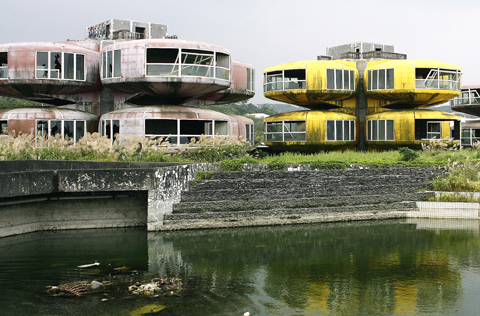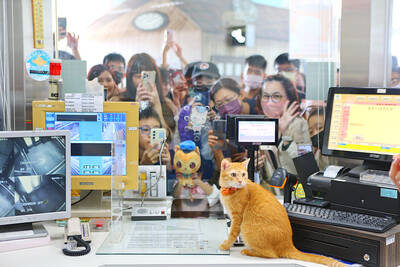Long a curiosity for people driving along the north coast between Tamsui and Keelung, the “UFO” houses as they are known locally — a group of freakish looking, brightly colored, run-down buildings that were once supposed to become a holiday village — made the headlines recently following the Taipei County Government's decision to demolish them.
Demolition work began on Dec. 29.
“We received an order to tear them down and we plan to finish the job within a month. I have no idea what will happen to the site afterwards,” said a site supervisor, who wished to remain anonymous.

PHOTO: JIMMY CHUANG, TAIPEI TIMES
The UFO houses are situated near the 17km marker of the Tamsui-Jinshan Road (Provincial Highway No. 2). These odd, circular, frisbee-shaped houses remind many people of UFOs, hence the name. Prior to being torn down, the site was often used as a location for photographers because of its unusual atmosphere and beautiful coastal setting.
Taipei County Public Works Bureau Director Lee Shu-chuan (李四川) said that construction work on the compound was never finished and the site has been abandoned for nearly 30 years. The government had no authority to order its demolition as it was owned by the Hung Kuo Group. Hung Kuo's financial problems, however, saw the site's ownership fall into the hands of three different banks.
“We eventually made a deal with the group and decided to tear it down. Hung Kuo and the Taipei County Government will work together to rebuild the site, including the beach front, into a scenic attraction and maybe a resort for tourists,” Lee said.
One of the designers behind the UFO houses spoke exclusively to the Taipei Times. Lin, who only gave his family name, said that there were lots of rumors about the site, but most of them were false.
“First of all, the site is definitely not haunted,” Lin said, in reference to oft-heard rumors that many people have seen ghosts near the complex or the high number of unexplained traffic accidents on the nearby road.
There were also rumors that more than 20,000 skeletons were discovered at the site when construction work began and that it was the scene of several murders.
Lin said that construction of the UFOs began in 1978.
“It is traditional in the construction business to pay your respects to any spirits at the site of a new project before you start work. It had nothing to do with the ghost stories,” Lin said.
Lin, now a freelance interior designer, was working as head of the design department at King Interior Design Co, a subcontractor for Hung Kuo, back in 1989.
Lin said that the original idea for the UFOs came from Sanjhih Township (三芝) plastics manufacturer Yu-chou Co. The first construction license was issued in 1978 and the idea for the design came from Matti Suuronen, an architect from Finland (www.arcspace.com/books/tomorrows_house/), but construction stopped in 1980 when Yu-chou went bankrupt.
Lin said that Hung Kuo had just started running Taipei's Hilton Hotel in 1989 and was looking to extend its tourism business. When Tsai Chin-hsien (蔡錦賢), the president of a local beer house in Tamsui called Haichungtien, proposed continuing with the construction of the UFOs, Hung Kuo offered to back it with NT$800 million (US$24 million) and became the manager of the project.
“They planned to make the compound into a large beer house and resort,” Lin said. “When Tsai took over, he decided to hire King Interior Design Co as the subcontractor and that was when I began to be involved in the project.”
Lin said that after taking over the project, he found that each UFO consisted of a reinforced concrete construction covered by fiber reinforced plastic. Earthquakes could damage such a construction and cause leaks and there was no way to fix such problems.
“We just wanted to finish the construction as soon as possible so we did not redesign or reconstruct the remaining half-completed houses,” Lin said.
He said construction was halted at the end of 1989 because Hung Kuo and Haichungtien had different plans for the compound and failed to reach an agreement.
“Haichungtien was a local business, but Hung Kuo wanted to make the site into an international resort. Unfortunately, the two ideas just did not fit together,” Lin said.
In 1995, Hung Kuo used the land to get loans from three banks because of financial problems, and the compound was left in its present state.
But the site will not lay derelict for much longer, it seems.
The Taipei County Government, according to Tourism and Travel Bureau Director Chin Hui-chu (秦慧珠), now has clear plans for the reconstruction of the site.
“With help from the Sanjhih Township Administration Office, we are planning to turn the site into a real tourist attraction by constructing hotels, beach facilities and more,” Chin said.

WANG RELEASED: A police investigation showed that an organized crime group allegedly taught their clients how to pretend to be sick during medical exams Actor Darren Wang (王大陸) and 11 others were released on bail yesterday, after being questioned for allegedly dodging compulsory military service or forging documents to help others avoid serving. Wang, 33, was catapulted into stardom for his role in the coming-of-age film Our Times (我的少女時代). Lately, he has been focusing on developing his entertainment career in China. The New Taipei District Prosecutors’ Office last month began investigating an organized crime group that is allegedly helping men dodge compulsory military service using falsified documents. Police in New Taipei City Yonghe Precinct at the end of last month arrested the main suspect,

A cat named Mikan (蜜柑) has brought in revenue of more than NT$10 million (US$305,390) for the Kaohsiung MRT last year. Mikan, born on April 4, 2020, was a stray cat before being adopted by personnel of Kaohsiung MRT’s Ciaotou Sugar Refinery Station. Mikan was named after a Japanese term for mandarin orange due to his color and because he looks like an orange when curled up. He was named “station master” of Ciaotou Sugar Refinery Station in September 2020, and has since become famous. With Kaohsiung MRT’s branding, along with the release of a set of cultural and creative products, station master Mikan

LITTORAL REGIMENTS: The US Marine Corps is transitioning to an ‘island hopping’ strategy to counterattack Beijing’s area denial strategy The US Marine Corps (USMC) has introduced new anti-drone systems to bolster air defense in the Pacific island chain amid growing Chinese military influence in the region, The Telegraph reported on Sunday. The new Marine Air Defense Integrated System (MADIS) Mk 1 is being developed to counter “the growing menace of unmanned aerial systems,” it cited the Marine Corps as saying. China has constructed a powerful defense mechanism in the Pacific Ocean west of the first island chain by deploying weapons such as rockets, submarines and anti-ship missiles — which is part of its anti-access/area denial (A2/AD) strategy against adversaries — the

Eleven people, including actor Darren Wang (王大陸), were taken into custody today for questioning regarding the evasion of compulsory military service and document forgery, the New Taipei District Prosecutors’ Office said. Eight of the people, including Wang, are suspected of evading military service, while three are suspected of forging medical documents to assist them, the report said. They are all being questioned by police and would later be transferred to the prosecutors’ office for further investigation. Three men surnamed Lee (李), Chang (張) and Lin (林) are suspected of improperly assisting conscripts in changing their military classification from “stand-by